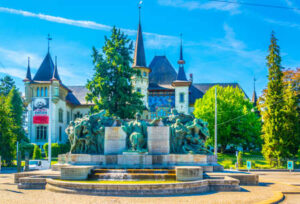Bern, the capital of Switzerland, is a beautiful and tranquil city full of museums, churches and historic buildings.
Established in the 12th century, and named after a bear found in a nearby forest, Bern’s most important building is the imposing Federal Palace. Open to the public when Parliament is not sitting, this domed structure is full of stained glass windows and statues.
Visitors must also take in Bern’s world heritage status Old Town, with its cobbled streets, arcades and fountains, and cross the turquoise River Aare to see four bears in Bern’s Bear Park (Barenpark).
Those looking for culture will find it in Bern’s Fine Arts Museum (Kunstmuseum), the Historical Museum of Bern, the Albert Einstein Museum (dedicated to Bern’s most famous resident), the Paul Klee Centre, and the Natural History Museum.
Other must-see attractions are Bern’s Cathedral (Bernmunster), complete with 330-foot bell tower and high-quality carvings, and Bern’s Rose Garden (Rosengarten). Bern also offers top hotels, high-class cuisine and shopping, and a number of famous festivals, such as the Gurtenfestival and Bern Jazz Festival.
1. Federal Palace
Built between 1894 and 1902, under the supervision of architect Hans Wilhelm Auer, the imposing Federal Palace is the national parliament of Switzerland.
The building is crowned by an imposing 64 metre-high green dome, decorated with stained glass windows depicting the coats of arms of Switzerland’s cantons and a central mosaic of the Federal coat of arms with the motto ‘One for all and all for one’.
Underneath the dome is found the Bundeshaus’ central hall, separating the two legislative chambers (the National Council and Council of States). Don’t miss the hall’s stained-glass windows illustrating Switzerland’s four regions and their main economic activities.
Another must-see is the huge statue of the three confederates, Uri, Schwyz and Unterwalden, the founders of modern Switzerland (who in 1291 swore the confederation oath on the Rutli meadow).
The National Council is the larger of Switzerland’s legislative chambers, with 200 members elected under a system of proportional representation (with one representative for each 40,000 or so voters). Its chamber is dominated by a large fresco by Giron representing the Confederation’s cradle.
With 46 members, the Council of States is much smaller (most cantons are permitted to send two representatives); its chamber is decorated with a large Albert Welto mural depicting a people’s assembly in the Nidwalden canton.
After each election, the members of the two chambers merge to form the Federal Assembly, responsible for electing the executive (called the Federal Council) and appointing Supreme Court judges. The Federal Council comprises seven members, from whom the Federal Chancellor (the Swiss head of state) is elected.
The adjacent newly renovated Parliament Square (Bundesplatz) is paved with granite slabs from the Alps and contains 26 hidden water-jets (one for each canton).
German, French, Italian and English language tours lasting 60 minutes are available when Parliament is in recess.
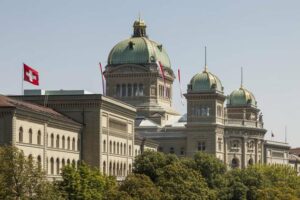
2.Bern’s Old Town
Surrounded on three sides by the turquoise waters of the River Aare, the medieval centre of Bern (aka the Old Town, Old City and Altstadt) was awarded UNESCO world heritage status in 1983.
The Old Town’s three principal streets run east from Bern’s Clock Tower. The wide, cobbled central street, running downhill to the Nydegg Church, is bordered by four-storey arcaded limestone buildings; their lower floors are filled with scores of independent shops, selling products ranging from high-class coffee, to antiques, books and couture (described by the tourist information centre as the longest covered shopping promenade in the world).
One of the upper floors was inhabited by Albert Einstein between 1903 and 1905 (his ‘annus mirabilis’); it has since been turned into the Einstein House Museum.
Fountains
Don’t miss the numerous public fountains found at regular intervals in the middle of the street, dating from the 16th century and crowned with statues representing biblical scenes or concepts such as justice.
The most famous statues include the Simsonbrunnen (depicting Samson killing a lion), the Zahringerbrunnen (a bear in full armour) and Lauferbrunnen (the Runner Fountain).
Clock Tower
The Clock Tower (or Zytglogge), dating from 1220, is one of Bern’s iconic symbols. Found above the Old Town’s western gate tower, this 75-foot structure displays a large astronomical clock made between 1527-1530. A troupe of mechanical figures—including a rooster, fool, knight and piper—put on a show at three minutes to the hour.
Visitors can climb the 130 worn steps to the Zytglogge’s observation platform, a former women’s prison, which offers great views over the rooftops and towards the Alps.
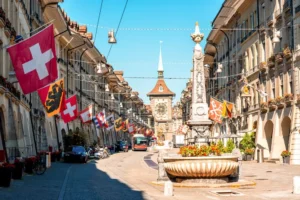
3.Rosengarten (Rose Garden)
To the east of the Old Town and Aare Loop is found the tranquil Rose Garden (Rosengarten).
Located at the top of a steep hill (a ten minute walk from the Bear Garden), and occupying four acres, the Rosengarten was a cemetery between 1765 and 1877 and has been a public park since 1913.
It contains formal and walled gardens (with 223 varieties of roses, together with 200 iris and 28 Rhododendron species), ponds, fountains, lawns and a number of impressive sculptures.
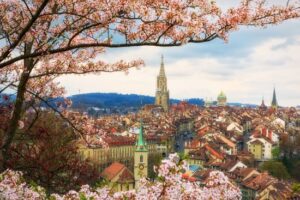
4.Bern Münster
Bern Münster (also known as Bern Cathedral or the Cathedral of St Vincent) is found in the heart of the Old Town next to the River Aare.
This three-naved protestant cathedral is of Gothic construction and built of sandstone from the nearby Ostermundingen.
Construction commenced in 1421, under the supervision of Strasbourg master stonemason Matthäus Ensinger, with the tower not completed until 1893. The Münster is 276 feet long, 110 feet wide, and 330 feet tall at the apex of its tower.
Belltower
The belltower is open to those prepared to climb the 254 steps to its upper viewing gallery. The views over Bern and to the Swiss Alps make the effort worthwhile.
On a clear day the Wetterhorn, Schreckhorn, Eiger, Monch and Jungfrau are all visible. The belltower is also home to the largest bell in the country, weighing 10.5 tonnes and rung every day at noon and 6pm.
Main entrance
The Münster’s main entrance displays the Last Judgment, a collection of over 200 wood and stone sculptures. Spared the violence visited on much of the interior during the reformation, this Edhard Küng work depicts sinners (naked) and the righteous (clothed) surrounding Michael the Archangel.
Stained glass
The Münster’s stained glass windows are another big draw. Dating from 1444-50, most feature heraldic symbols and religious imagery. The most striking is the Matter Chapel’s Dance of Death; this 16th century work by Niklaus Manuel depicts skeletons symbolising death claiming the lives of the working classes and the great and good alike. Such works were common at the time of the Black Death.
Services are held on Saturdays and Sundays, with the Münster hosting concerts and cultural events throughout the year. The adjacent Münsterplatz, a pretty cobbled square, holds an annual Christmas market and is home to the 1545 Moses Fountain.
where? Bern Münster, Münsterplatz 1, Postfach 532, 3000 Bern 8.
when? May-early Oct: 10am to 5pm Mon to Sat; 11.30am to 5pm Sun. Other times: 12pm to 4pm Mon to Fri; 10am to 5pm Sat; 11.30am to 4pm Sun.
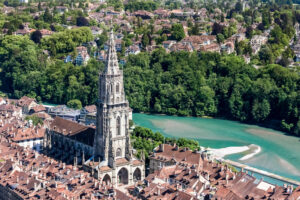
5.Bern’s Bear Park (Barenpark)
Bern (or Berne) was founded by Duke Berthold V of Zähringen in 1191.
Legend has it that the Duke named Bern after a bear he encountered whilst hunting in the surrounding forest (one of the German words for ‘bear’ is ‘bären’). (Another less romantic theory is that Bern was named after Verona, the word for which was Bern in Middle High German.)
By 1220 the bear had made its way onto Bern’s coat of arms, and in 1513 the Bernese returned victorious from the Battle of Novara carrying a bear. The bear had, therefore, become synonymous with Bern.
Bern’s first Bear Park (aka the Bear Pit, Bärenpark or Bärengraben) opened in 1857. Found at the far end of the Nydeggbrucke bridge, next to the River Aare, the original bear pit is listed as an object of national cultural significance.
Today, the bear pit and 6,000 square metres of interconnected enclosures house four brown bears: Byörk and Finn and their two cubs, born in December 2009, Ursina and Berna. They are often to be found play-fighting in their grassy enclosure, swimming in the ‘bear bath’, or eating apples, melons or other vegetarian fare.
The new complex, opened in 2009, cost CHF24 million (twice the initial budget). But there was no complaint from the 40,000 locals who turned up to watch the opening ceremony.
where? Bear Park (Bärenpark), Grosser Muristalden 6, 3006, Old Town, Bern.
when? Daily, 8am to 5pm.
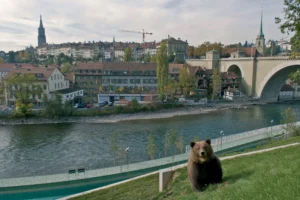
6.Einstein Museum and Historical Museum of Bern
The Historical Museum of Bern (aka Historiches Museum Bern and Musée d’Histoire de Berne), incorporating the Einstein Museum, is the second largest museum in Switzerland.
Housed in an imposing 1894 Andre Lambert designed building, based on historic castles from the 15th and 16th centuries, the Museum is found on the Helvetiaplatz (a short walk across the River Aare from the Old Town).
The Historical Museum
The Historical Museum’s permanent collection displays 500,000 objects dating from the Stone Age, arranged into eight galleries such as ‘Stone Age, Celts and Romans’, ‘From the Middle Ages to the Ancien Regime’, ‘Bern’s Silver Treasure’, ‘Captured Treasure—Court Art in Bern’ and ‘Bern and the 20th Century’.
Highlights include objects from the burial site of a Bronze Age leader from nearby Thun, Flemish tapestries from the 15th century, a Königsfelden diptych painted for the King of Hungary, a Bodhisattva Buddha from South Asia, a Japanese Daimyo suit of armour and a Hawaiian feather cloak collected by Captain Cook.
The Museum’s current temporary exhibition (until June 2020) is Homo Migrans, covering a long period in our history, beginning with the first human beings in Africa, then charting their gradual spread across the globe two million years ago and culminating in a look at Switzerland today.
The Einstein Museum
The Einstein Museum is devoted to the life of the world’s most famous modern scientist. Einstein (1879-1955) lived in Bern between 1903 and 1909, working as a patent office clerk and then as a lecturer at the University of Bern; it was during this period that Einstein published his 1905 Annus Mirabilis papers on photoelectric effect, Brownian motion, the special theory of relativity and E=mc2.
The Museum traces the different aspects of Einstein’s life in 1000 square metres of exhibition space. There are over 550 original objects, 70 films, and a number of animations.
Highlights include Einstein’s (very average) school reports, numerous letters sent or received by Einstein (such as a letter warning President Roosevelt of German nuclear capabilities in 1939 and a letter inviting Einstein to become the President of Israel in 1952), a gallery devoted to Einstein’s many lovers, interactive displays explaining the special and general theories of relativity, and Einstein’s 1921 Nobel prize certificate.
where? Helvetiaplatz 5, 3005 Bern. T: 031 350 7711. E: info@bhm.ch.
when? 10 am to 5 pm, six days a week. Closed Mondays.
